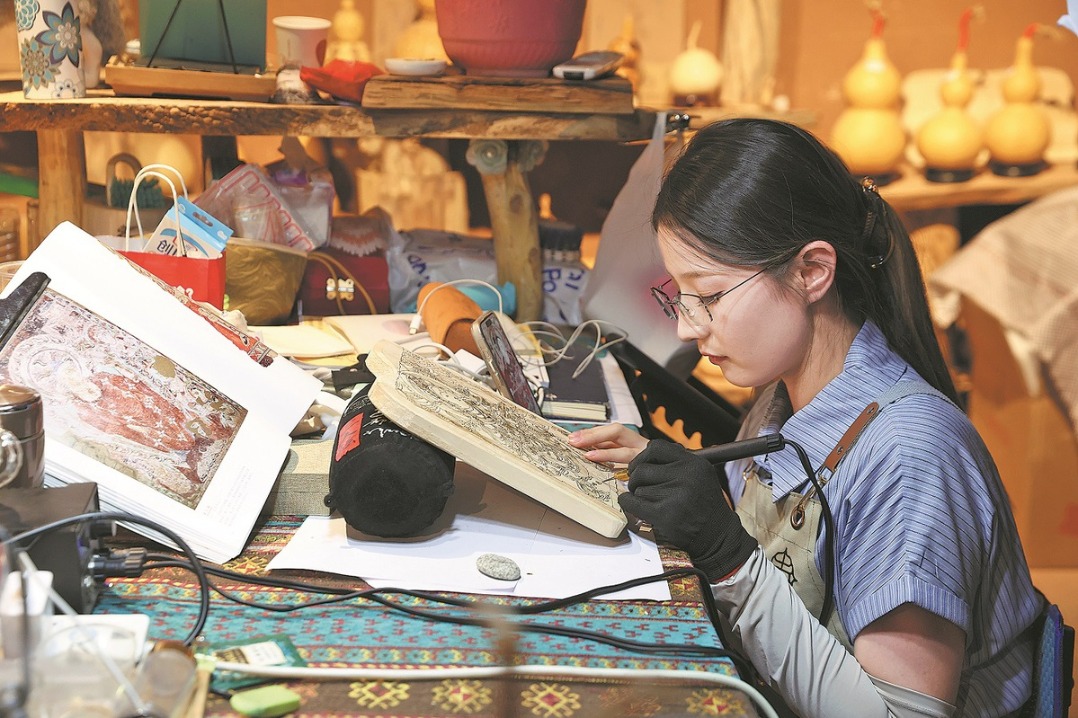Going for a circular economy


Designer brands' pushback on the second-hand market, consumers' aversion to and paranoia of used apparels and the coveted thrill of upgrading wardrobes pose multiple challenges for sustainable consumption to take the reins.
Making consumption less environmentally destructive is the raison d'etre of the second-hand market. The logic is obvious — buying second-hand, or pre-owned, clothing allows us to enrich our wardrobe without exhausting Mother Nature by manufacturing it from scratch and overstretching the landfill to decompose.
According to British charity group Waste and Resources Action Programme, extending the average life of a piece of clothing by just three months — from 2.2 years to 2.5 years — would lead to a reduction in carbon, water and waste footprints by 5 to 10 percent.
Trendy design, exquisite details and excellent quality alone can no longer win over consumers, while young shoppers are a picky cohort, adhering to products and brands that align with their values. A global survey, The Sustainability Imperative, conducted by US data, information and marketing group Nielsen in 2015 showed that 66 percent of respondents and 73 percent of millennials would pay extra for sustainable products.
Counterintuitively, designer brands are hesitant about jumping on the resale bandwagon and even tenaciously resistant. French luxury fashion house Chanel sued The RealReal — an online marketplace — for selling counterfeits and delivering a misleading impression that its brand is affiliated with the platform. Many designer labels are extremely protective of their brands, credibility, and reputation that they have strenuously cultivated over a century. "They're mostly concerned about their image. They want to control the narrative around their products to guarantee a high level of customer experience throughout the purchasing process," said Alan Della Noce, fashion creative director and professor of design at Italian scientific-technological university, Politecnico di Milano.
The frenzied adoption of the second-hand market by millennials and Generation Z, who are the main trend setters in fashion business, will drive wider social acceptance of resale across different age and social groups, said Michel Gutsatz, adjunct professor of marketing at China Europe International Business School at HKU Space. "Previously, these products could only be bought in many second-hand shops in Hong Kong. The very first question a person would ask oneself is: Are they real or fake? This is a huge concern and challenge luxury brands will have to tackle. If they want their second-hand products to become a real market, they must find ways to guarantee their authenticity," said Gutsatz, an expert in brand management.
Shift to resale market
Amid the resale market momentum, some brands have chosen to accept it, though grudgingly. Passive acceptance will persist for some time until the resale market grows to be a big part of, or entrenched in the entire luxury market, predicted Barbara Khan, a professor at the University of Pennsylvania. As the resale market continues to make inroads into the primary luxury market, the brands will alter the landscape of the luxury market and restructure the resale market. "I reckon luxury brands will come up with their own pre-certified, second-hand business themselves at some point, because I don't think they'll one day love the idea that the first purchase will not be for themselves," said Khan.
On top of helping to slash the footprint of our wardrobe, the resale market can facilitate sales in the brands' primary market, Khan said, "because it offers an entry point for first-timers to experience the brand affordably and even fall in love with it." Boston Consulting Group research shows that nearly 50 percent of pre-owned shoppers last year tried a new brand, concluding that pre-owned consumption is a key driver of customer acquisitions.
However, if the resale market overgrows, it could backfire on the brand. It'll not only cannibalize the new products, but also undermine the value of its first-hand commodities and, consequently, the brand faces the threat of losing its die-hard customers.
"If the older customers who shelled out a lot on first-hand luxuries see the younger, less wealthy people running around with the same thing, they'll find the brand less attractive and stop buying it. It's a kind of push-pull thing," Khan added. So the more accessible the resale market is, the more likely it'll antagonize the older and wealthier cohorts. The fear of turning off their moneyed clientele makes the brands stiffen their control over the resale market even more.
If most of the influential brands steer clear of the resale market, sustainable fashion will remain an elusive mirage.
But, even if the resale market is really in a full swing, does it necessarily mean a giant leap toward sustainable consumption? To John Zhang Zhong, professor of marketing at the Wharton School of the University of Pennsylvania, the answer is ambiguous.
Zhang's speculation pertains to another question: Is consumers' motivation for buying second-hand products driven by sustainability or cost? They're fundamentally different as the former can perpetuate one's sustainable consumption, while the latter would only lead one to consume more.
There's a slight difference between Asian consumers and their European counterparts when it comes to the driving force behind buying second-hand goods, said Hong Kong educator in fashion Robert Meeder. "I'm looking at the second-hand clothing segment from a kind of holistic aspect of sustainability and environmental reasoning. One of the biggest driving factors in the West is saving the environment. But that may not necessarily apply to Asia, he said, where consumers may not give much thought to the environmental impact in this discussion. "They could take it (the resale market) as an opportunity for affordable or economic trends, probably thinking 'I can own a trench coat for this season, and then I will sell it on the second-hand site the next season, and buy a new style in trend.'"
The second-hand market's resurgence is visible worldwide, but at different scales and paces, Tanja Wessels, co-founder of Revive Consulting, said on the sidelines of Fashion Summit 2021 held in September. "When I went to London a couple of years ago, I realized there were fewer good quality products in the high street charity shops. I asked the contractor what's going on. They said 'People are waking up to sustainability and demanding more thrift goods. So a lot fewer are available'. In Hong Kong, where I've been living, consignment stores are quite a niche."
The vestige of fear, disgust, and superstition about wearing used items from others creates a psychological block that prevents Hong Kong people from embracing things second-hand, she said. "They would rather spend more money on a product that's of lower quality but new, than to buy a something second-hand."
Feeling the urge to espouse sustainability, fast-fashion brands, such as H&M and Zara, have launched take-back programs, where customers are encouraged to chuck their old clothing into recycling bins in exchange for coupons or discounts. Having witnessed how the collected hauls were sorted out, Wessels said the amount was staggering — a roomful. However, this does not necessarily mean that Hong Kong people are sustainability-driven. "Hong Kong people have huge consumption power, but they lack the space to store their belongings. So, if they get rid of such a bulk of old garments, that could mean they'll have to buy more new stuff."
The difference in motivation also manifests itself in students who study sustainability. Chris Lo, associate professor of Institute of Textiles and Clothing at the Hong Kong Polytechnic University, said students always care about the recognition and career prospects they can get by studying the subject, but foreign exchange students aren't on the same page. "Hong Kong students are very transactional, while foreign students seem to buy into the values of sustainability concept, which prompts them to take the course."
Step to sustainability
Lo regrets to say we're "failing" in sustainability education, both for students and the public. Attempts to convince people in senior management to make sustainability a stand-alone discipline in Hong Kong are fruitless. Although the sustainability concept is covered in other major disciplines, such as design, corporation management, branding, and marketing, he said it's not enough. The word "sustainability" has yet to make its way into the curriculum at universities. "It's too slow."
Theoretically, the second-hand market provides a sustainable alternative to buying goods. However, there're some indecisive voices and even criticisms.
"Sustainability is a convenient and fashionable wagon to jump on for a lot of people today. However, it's not clear to me that the growth of the second-hand market for luxury goods will necessarily lead to more sustainability," said Zhang. He reasoned that when commodities, including luxury goods, become more divisible, people are motivated to pay more and use more. An analogy he uses to illustrate is the emergency of rental cars in the auto market which, coupled with carpooling services offered by DiDi and Uber, encourages more people to use cars and buy cars.
Some critics decry that "sustainable consumerism" or "green consumption" is an oxymoron. Fashion itself is wasteful and incompatible with sustainability in the first place. Things like importing supposedly "organic" cherries from Chile, holding a "green" fashion show that hosts thousands of people from different parts of the world, or building a 186-square-meter villa made of "eco-friendly" materials are considered jokes.
"Sustainable consumption is an oxymoron — consumerism is not sustainable," contends Della Noce.
"I prefer using the term 'sustainable consumption', which is not an oxymoron — consumption is there to stay," said Gutsatz. The real question is: "Are consumers primed to adopt a responsible attitude to how they consume?" The only way to address the question for fast fashion, he suggests, is to adopt a "completely different way of thinking — a circular economy".
To be sustainable, the fashion system should revolutionize the entire process, said Della Noce. "Consumers first have to reduce their appetite for newness, and change their purchasing habits by buying less, but more durable and versatile products." By "versatile" he means high quality, less trendy and seasonless. Institutions should also incentivize sustainable practices and punish irregularities in environmental management, while retailers need to focus on conscious purchasing and promote sustainable brands, he said.
Although the circular economy is gaining currency globally, the business model that still dominates most industries "where the only thing that's valued is, more and more and more" is toxic, said Wessels. "Even brands may proclaim they're committed to sustainability, or talk about using more eco-friendly materials, or sustainable processes, they rarely talk about making less or reducing their volumes."
The psychology in our lives is to buy things to feel better, to show we have money or to give ourselves a treat, said Wessels. Everything about people is designed to respond to the marketing, the branding and the incentives offered. Think about our childhood when our parents would buy us gifts as rewards for what we had achieved. Such psychology is so ingrained in us when we see purchasing as a feel-good factor, which businesses are cashing in on.
Before the business model is transformed to become truly circular, we need to undo the psychological conditioning and learn to find joy through things that aren't necessarily consumable consumption driven, Wessels said.
"We need to understand that those things have never really made us that happy because, if they did, why would we need to keep doing it?"
- Forum explores promotion of sustainable development through community education
- China pledges greater role in UN peacekeeping
- SCO forum calls for greater global collaboration on traditional medicine
- China's nuclear policy highly stable, continuous, predictable: spokesman
- Beijing condemns US remarks on Taiwan status
- Hong Kong's role in promoting TCM highlighted at forum





































